Introduction:
- India had commercial contact with European countries from time immemorial.
- With the arrival of Alexander the Great these relations became still more intimate.
- There was a great demand for Indian goods like silk, spices, muslin and handloom fabrics in Europe.
- India exported pepper, cloves, chillies, cinnamon, ginger, coconut, canesugar, indigo etc. to western countries through three major trade routes.

Fig : Trade Routes
The three important trade routes were,
- Through Afghanistan, Central Asia and the Caspian Sea and terminating at the Black sea Coast.
- Though Persia and Syria leading to the port of Alexandria on the Mediterranean coast of Europe.
- The sea route passing through the Arabian sea, Persian Gulf and the Red sea.
- But in 1453 AD, the Ottoman Turks captured Constantinople and troubled the European merchants by blocking the land route which passes through Afghanistan.
- The other two routes were also closed as a result of the Arab conquest in the 8th century AD.
- So the Europeans were forced to discover a new sea route to India.
The Portuguese
- The Portuguese were the first to discover a new sea route to India.
- Prince Henry of Portugal started a school for training seamen on scientific navigation.
- Due to his interest and enthusiasm in the field of Navigation, he has been called “Henry, the Navigator”.
Bartholomeu Diaz
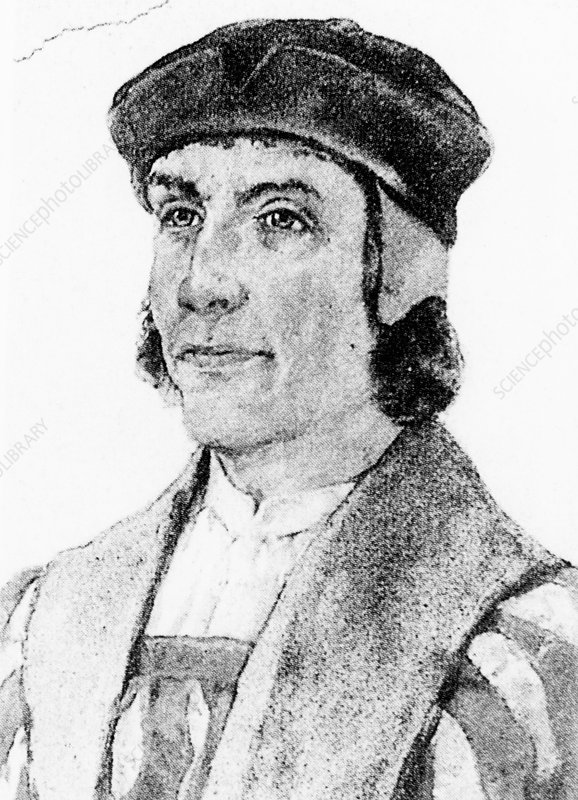
- He was the first sailor from Portugal who set out on his voyage in 1487 AD.
- He came upto the southernmost tip of Africa.
- As there was a storm when he reached there he named it the Cape of Storms.
- Later on, The Cape of Good Hope with a definite hope of discovering a sea route.
Vascodagama
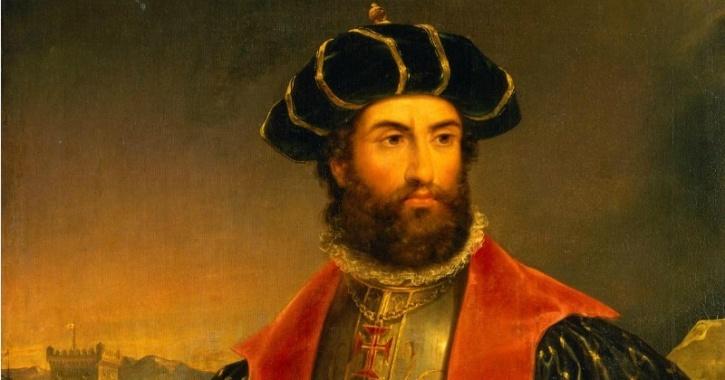
- On 27th May 1498, a Portuguese sailor, Vasco- da- Gama crossed the Cape of Good Hope and reached Calicut in India.
- He was given a warm reception by the Hindu ruler King Zamorin of Calicut.
- In 1501 he came to India for the second time and set up a factory at Cannanore.
- Thus the Portuguese established their factories at Calicut, Cochin and Cannanore, on the West coast of India.
Francisco- de- Almeida (1501- 1509 A.D)
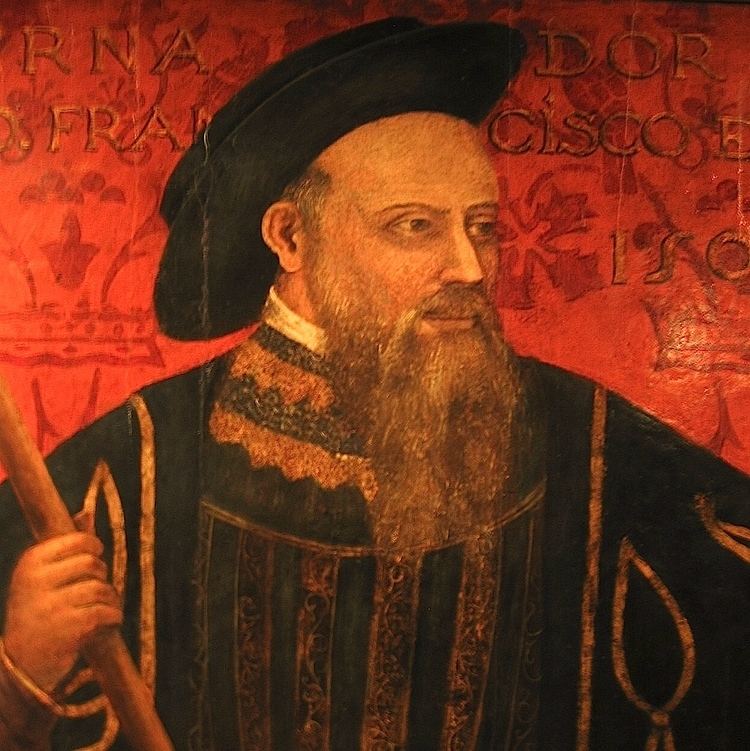
- Francisco- De- Almeida was the first viceroy of the Portuguese possessions in India.
- During his period the Portuguese defeated the Arab traders.
- His policy was to increase the Portuguese naval power so that they might become the masters of the Indian Ocean.
- This policy of controlling the other countries settlement by naval force was known as the “Blue water policy” in 1509.
- Almeida was defeated and killed by the Egyptians.
Alfonso- De- Albuquerque (1509-1515 AD)
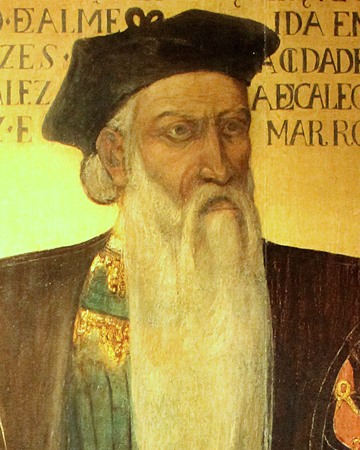
- Albuquerque was the second viceroy if the Portuguese in India.
- He was a great conqueror.
- He captured Goa from the Sultan of Bijapur in 1510 and made it the capital.
- He also strengthened his relationship with the Vijayanagar Empire.
- In 1511, he captured Malacca in the far East and in 1515 he built the port of Ormuz in the Persian Gulf.
- He can be rightly called the Real Founder of Portuguese power in India.
- He was a good administrator.
- He treated the Hindus well and opened schools for their education.
- The Muslims became an enemy of the Portuguese because of their religious policy.
- He encouraged marriages between the Portuguese and the Indian women.
- He died at Goa in 1515.
- After the death of Albuquerque, the Portuguese conquered Diu, Daman, Bombay, Ceylon, Salsette, Bassein and Hughli.
- After about a century the Portuguese power declined.
Causes for the decline of the Portuguese power in India
- Albuquerque’s successors were weak.
- They could not strengthen the Portuguese hold over India.
- The Portuguese indulged in piracy against the Indian merchants.
- The Portuguese often forcibly converted the natives to Christianity.
- They also destroyed some temples in India.
- Their religious policy created enmity of the Muslims.
- The Portuguese maintained a good relationship only with Vijayanagar Kingdom.
- Therefor the fall of Vijayanagar Kingdom in the battle of Talikotta 1565 AD was a great blow to the Portuguese.
- In 1580, Portugal came under the rule of Spain.
- The arrival of the Dutch and the English weakened the Portuguese power in India.
The Dutch

- After the decline of the Portuguese power, the Dutch arrived India.
- The Dutch people of Holland founded the Dutch East India company in 1602 and began to trade with Eastern countries.
- They concentrated in East Asia celled “Spice Islands”.
- The Dutch company established its trading centres at Chinsula, Nagapattinam, Surat and Masulipattanam.
- They founded Pulicat near Madras in 1610 and built a fort there.
- They also established trading centres at Surat, Broach, Cambay, Ahmedabad, Patna and Kazimbazaar.
- Meanwhile the English also sent their merchants to do the spice trade but the Dutch did not like the British interference over there.
- They made a plan against the English merchants and killed many of the English merchants at Amboyna in 1623 AD which came to be known as Amboyna Massacre.
- This incident created enmity between the English and the Dutch.
- Then the English left the spice Islands and concentrated their trade in India
- In India, the English had grown very powerful and the Dutch were no match for them.
- In 1759 the English captured Chinsura from the Dutch and a little later they also captured Nagapattinam.
- Thus the Dutch power in India came to an end.
The British
- In 1588, the English defeated the Spanish Armada and consequently became the most important naval power of Europe.
- Then they thought of establishing colonies in the Eastern countries.
- So the English East India company was started by 100 London merchants who received permission from Queen Elizabeth-1 on December 31st 1600 to carry on trade with the East.
- In 1608, King James 1 of England sent Captain William Hawkins to the court of the Mughal Emperor Jahangir to obtain permission to establish a factory at Surat.
- However permissions was not given as the Emperor was influenced by the Portuguese.
- In 1615, Sir Thomas Roe arrived at the court of Jahangir and succeeded in getting permission to set up their trading centres at Agra, Broach and Ahmedabad.
- In 1639, Francis Day bought a piece of land from the Raja of Chandragiri and laid foundation for modern Madras for a small rent.
- In 1640 the English built Fort St. George to protect their trade.
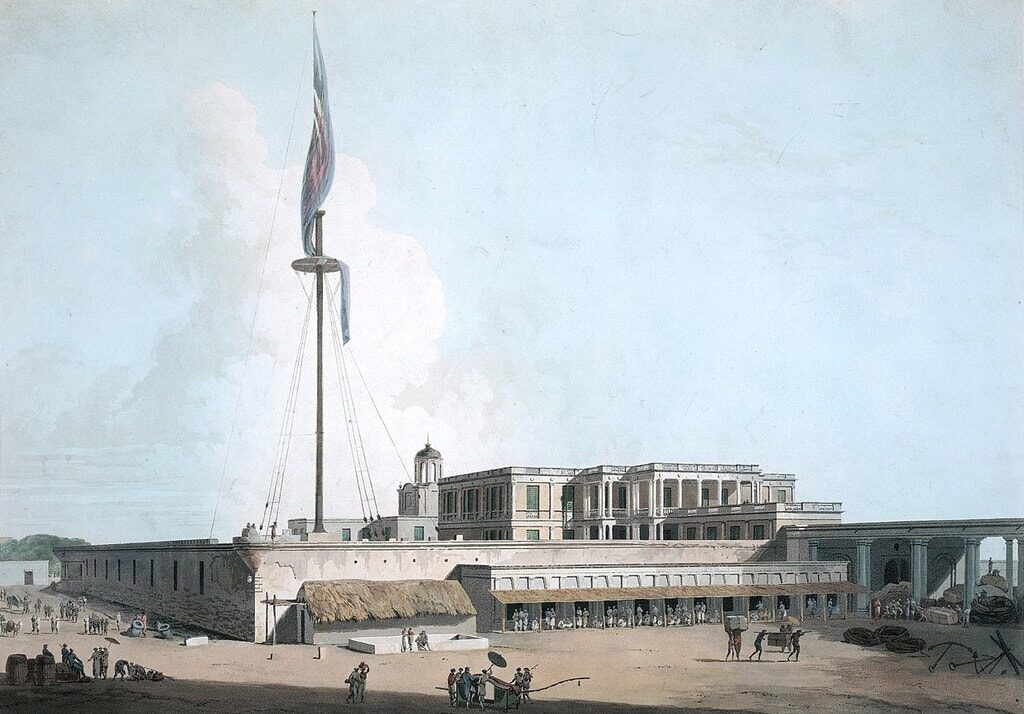
Fig : Fort St. George
- Charles II, the King of England married Catherine the daughter of the King of Portugal.
- He got Bombay, a small village as a part of dowry.
- In 1668 Charles II gave Bombay on lease to the English East India company at a nominal rent of £ 10.
- In 1699 they got permission from Aurangazeb and set up a factory at Calcutta.
- Later they built a fort and named it Fort William after King William II.

Fig : Fort William
- Then they established factories at Hariharpur, Balasore, Hughli and Kazimbazaar.
- The British settlements soon developed into centres of commercial activities.
- Thus the English East India company expanded its influence and control over India till 1858, when the administration of India was taken over by the British Crown from the East India company.
The Danish
- The people of Denmark were known as Danish.
- They began to trade with India.
- In 1620 they established their trading centre at Tranquebar and in 1676, at Serampore in Bengal.
- By they never concentrated on India and sold their trading centres to the British and left India.
The French
- Like other European countries, France too realized the importance of trading with India.
- The French East India company was established in 1664 by Colbert a minster of Louis XIV, the king of France.
- They set up their factories at Surat in 1668 and Masulipattanam in 1669.
- In 1674 they got a place to the south of Madras from the ruler of Tanjore and laid the foundation of Pondicherry, which became the headquarters of the French settlements in India.
- In 1690 they established their settlement at Chandranagore.
- They got Mahe in 1725 and Karaikal in 1739.
- Duplex came to India 1742 as the Governor of the French possessions.
- Under him the French increased their influence all around.
- Under such circumstances there was bound to be a conflict between the French and the English to establish supremacy in India.
- The clash of trade interests down between the two ultimately led to a series of wars called the Carnatic wars.
- Finally the English came out successful and established their power in India by sending the French out of India.
ANGLO- FRENCH STRUGGLE (CARNATIC WARS)
- The English and the French East India companies were established with the motive of trading with India.
- In course of time their competition turned into rivalry and both the powers tried to remove the other from the Indian scene.
- Their trade interest was also diverted towards politics.
- Making use of the situation and the rivalry among the native rulers, the English and the French tried to capture power in India and to establish their supremacy.
- Between 1740- 1763 the rivalry between the English and the French led to three wars in India.
- These wards were known as Carnatic wars as they were fought in the Carnatic region.
- Carnatic was originally a Mughal province under the Nawab.
- It was ruled by Anwar- ud-din, the Nawab of Carnatic.
- The Nawab ruled the territory as an independent ruler.
- Arcot was the capital of Carnatic.
- The British and the French exploited the region to strengthen their power.
- In the end, the British drove the French out of India by 1763 and established their supremacy over the Carnatic region.
The first Carnatic war (AD 1746-AD 1748) Causes
- This war was an echo of the Austrian war of Succession.
- In this First Carnatic war, the English and the French took opposite sides.
- They began to fight in India in 1746.
- Dupleix, the French Governor of Pondicherry had an ambition to establish French power in India.
Course
- Dupleix wanted to make the French power supreme in South India.
- When the war started in Europe, Dupleix sent an appeal to La Bourdonnais, the Governor of Mauritius to capture Madras.
- He besieged Madras and captured it in 1746.
- The Nawab of Carnatic, Anwaruddin did not like this.
- So he sent an army against the French.
- At Santhome on the banks of the river Adayar, Anwaruddin’s army was defeated.
- Then Dupleix tried to capture Fort St. David from the English but failed.
- Later the English attacked Pondicherry but the French successfully defended the city.
- In 1748 the war of Austrian succession came to an end in Europe.
- So the Carnatic war also came to an end in India.
Results
- The First Carnatic war came to an end by the treaty of Aix- la-Chappelle (1748).
- As a result the English got back Madras.
The second Carnatic war (AD 1748-AD 1754) Causes
- The second Carnatic war was connected with the succession disputes between the Nizam of Hyderabad and the Nawab of Carnatic.
- The Nizam of Hyderabad, Asaf Shah died in 1748.
- There arose a competition between his osn Nasir Jung and his grandson Muzzafar Jung.
- At the same time the Nawab of Carnatic, Dost Ali died.
- There was a dispute between Anwar- ud- din and his son-in-law Chanda Sahib for the throne of Arcot.
- The French supported Muzzafur Jung and Chanda Sahib.
- Hence Nasir Jung and Anwarud-din were forced to seek the assistance of the English.
- So a war broke out in 1748.
Course
- With the help of the French, Muzzaffar Jung and Chanda Sahib defeated and killed.
- Anwar- ud- din at the battle of Ambut in 1749.
- But his son Mohammad Ali took refuge in the fort of Tiruchirappalli.
- Chanda Sahib became the Nawab of Carnatic.
- In Hyderabad. Both Nasir Jung and Muzzaffar Jung were killed General Bussy, the French Governor made Salabat Jung the Nizam of Hydereabad.
- In return for the French help, he handed over the Northern circars to the French.
- The condition of the English became very critical.
- Robert Clive a clerk in the English East India company changed the course of the war.
- He attacked Arcot, the capital of Carnatic.
- He defeated Chanda Sahib and made Mohammad Ali, the Nawab of Arcot.
- Clive was called as the “Hero of Arcot”.
- Dupleix recalled in 1754 and was succeeded by Godeheu.
Results
- The second Carnatic war came to an end with the Treaty of Pondicherry in 1755.
- By this treaty both the sides agreed not to interface in the internal affairs of the Indian princely states and returned each others territories captured during the war.
- Mohammad Ali was acknowledged as the Nawab of Carnatic.
The third Carnatic war (AD 1756-AD 1763) Causes
- In 1756 the seven years war broke out in Europe and the same war echoed in India as the Third Carnatic war.
Course
- The French General Count de Lally captured Fort St. David.
- Bussy the French General at Hyderabad was asked to attack Madras which was a great blunder committed by the French.
- When Bussy left Hyderabad the British captured Hyderabad.
- Count de Lally and Bussy together attacked Madras.
- But the British general, Sir Eyre Coote defeated both the French generals at the battle of Wandiwash in 1760.
- In the nexr year 1761 Count- de- Lally surrendered Pondicherry to the British.
Results
- The war came to an end with the Treaty of Paris in 1763.
- Pondicherry, Karaikal, Chandrangore and Mahe were returned to the French but they were not allowed to fortify them.
- The French lost all their prestige and influence in India.
- British became more powerful in India.
Causes for the success of the British
- Britain was commercially superior and the British in India were supported by the Home government.
- The naval power of the British was far superior to that of the French.
- There was full co-operation among the English officers.
- The mistakes committed by Count-de-Lally enabled the British to capture Madras.
- The British could concentrate on wars as there was peace in England while the French were too busy fighting wars in Europe.
Establishment of British supremacy over Bengal
- Bengal a very rich province of the Mughal Empire developed unto an independent kingdom under Alivardi Khan.
- After his death, his grandson Siraj-ud- daulah became the Nawab of Bengal.
- The battle of Plassey was a result of a quarrel that arose between Siraj-ud- daulah and the British in 1757.
Battle of Plassey (AD 1757) Causes
- The English and the French were strengthening their fortification in Bengal.
- Siraj-ud- daulah, Nawab of Bengal asked them not to fortify their forts.
- The French obeyed but the English refused to do so.
- More over the British were misusing their trade privileges.It enraged the Nawab.
- Siraj-ud- daulah marched with his army and captured Calcutta.
- One hundred and forty six British soldiers were taken as captives and they were locked up in a very small room.
- Most of them died due to suffocation.
- Only twenty three of them were survived. This incident in history is called as the Black Hole Tragedy.
- On hearing about this tragedy, Admiral Watson and Robert Clive were sent to Bengal. They recaptured Calcutta.
Course
- On 23rd June 1757 Siraj-ud- daulah met Robert Clive in a village called Plassey near Calcutta.
- Within a few hours, the Nawab was defeated and killed.
- The British appointed Mir Jafar as the Nawab of Bengal.
Battle of Buxar
- After few years Mir Jafar was removed and Mir Qasim was made the Nawab of Bengal.
- A misunderstanding developed between Mir Qasim and the British.
- Mir Qasim was also removed, so he entered into an alliance with Shuja-ud- daulah the Nawab of Oudh and Shah Alam II the Mughal Emperor against the British and invaded Bengal.
- A battle between the combined army of Indian rulers and the British took place at Buxar on October 22, 1764.
- In this battle, Mir Qasim fled from the battlefield while Shuja II surrendered to the British.
Results
- The Treaty of Allahabad was signed in 1765 between the English in one side and Shah Alam II and Shuja-ud- daulah on the other side.
- Shuja-ud- daulah was asked to pay a war indemnity of 50 lakhs to the British and also gave Kara and Allahabad to the British.
- The Mughal Emperor was given an annual pension of rupees 26 lakhs.
- Shah Alam II granted the Diwani rights of Bengal, Bihar and Orissa to the English.
- Bengal, Bihar, Orissa and Carnatic practically came under the control of the British.
- The Battle of Buxar made the English East India company a sovereign power in India.
- After the Battle of Buxar, Robert Clive became the Governor of Bengal on 1765 AD.
Hyder Ali
- Hyder Ali ws born in 1722.
- He was the son of a Faujdar and he started his career as an ordinary soldier.
- He rose to the position as the chief of the Army due to his hard work.
- When a civil war broke out in Mysore, Hyder was in Dindigul.
- The King of Mysore asked for his help.
- After arriving at Mysore, he over threw the king and ascended the throne of Mysore.
- Though he was illiterate, he was very intelligent.
- He treated both the Hindus and the Muslims alike.
- He was known for his impartial justice.
The first Anglo- Mysore war (AD 1767- AD 1769) Causes
- Mysore under Hyder Ali emerged as one of the most powerful kingdoms.
- Hyder Ali’s growing power and his friendly relations with the French became a matter of concern for the English East India company.
- This led to the First Anglo- Mysore war.
Course
- In 1766, the British, the Marathas and the Nizam formed a coalition against Hyder Ali.
- But Hyder Ali was very clever and the bribed the Marathas and the Nizam and won over their support.
- But in 1767 Hyder Ali and the Nizam were defeated at Changma by the British.
- Hyder Ali captured Ambur and Mangalore and established his rule.
- Then he captured Baramahal, Karur, Tanjore and Cuddalore.
- He then besieged Madras which forced the English to sign the Treaty of Madras in 1769.
Results
- The Treaty of Madras was signed in 1769.
- Both the sides agreed to restore places.
- The first Mysore war ended in favour of Hyder Ali.
Robert Clive
- Robert Clive became the Governor of Bengal in 1765.
- During his first tenure as a governor he was known for his conquests and during his second tenure for his administrative reforms.
Administrative Reforms
- The servants of the company were forbidden to receive any gift from Indians.
- They were forbidden to indulge in private trade.
- He increased the salaries of the company’s servants.
- Robert Clive gave double Bhatta (field allowances) to the officers in times of peace.
- He set up a fund known as Lord Clive’s Fund with a view to help poor servants of the company and widows of those who died in service,
- After receiving the Diwani (civil) and Nizamat (Criminal) rights from the Mughal emperor Shah Alam II, Robert Clive introduced a new system called Dyarchy or Dual or Double government.
- According to this system, the British enjoyed all powers but no responsibility.
- The Nawab was reduced to a position of all responsibility and no power.
- In this system of government, neither the Nawab nor the English cared for the welfare of the people.
- The Dual government was finally abolished in 1772.
- Bengal was brought under the direct rule of the company.
